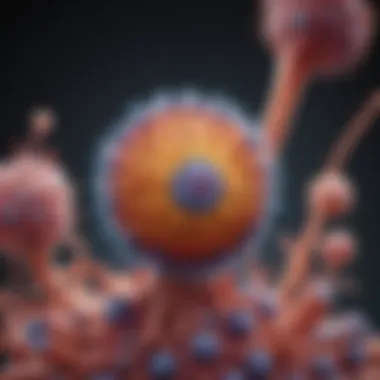Emerging Treatments for HPV: Latest Advancements


Intro
Human Papillomavirus (HPV) represents a critical threat to global health, closely linked with various cancers and other diseases. With over 100 different strains of the virus, some can lead to significant health complications, necessitating an urgent response in terms of treatment options. Recent progress in medical research has introduced new therapies that offer hope for improved management of HPV-related conditions. This article delves into these emerging treatments, examining their mechanisms, clinical applications, and future possibilities.
Key Findings
Summary of the Main Results
Recent studies have spotlighted several novel treatment strategies for HPV, diverging from traditional approaches. Notable advances include:
- Vaccination: Updated vaccines such as Gardasil 9 provide broader protection against more strains of HPV.
- Immunotherapy: Treatments using immune checkpoint inhibitors are demonstrating promise in clearing HPV infections.
- Targeted therapies: Agents like Cidofovir are being investigated for their efficacy in managing warts and lesions caused by the virus.
The significance of these findings lies in their potential to transform current medical practices. The adaptability of these new methods addresses the limitations of conventional treatments, highlighting the importance of ongoing research.
Significance of Findings Within the Scientific Community
The emergence of these treatments alters the landscape of HPV management. Scientific inquiry into HPV is shifting focus from purely preventative measures to effective therapeutic strategies. Enhanced understanding of the HPV biology undoubtedly plays a crucial role in this transition.
Implications of the Research
Applications of Findings in Real-world Scenarios
The practical implications of the research findings extend into various areas. Health professionals and patients alike benefit from:
- Improved patient outcomes through effective management of HPV-related diseases.
- Informed medical decisions, as the new understanding allows for tailored approaches to treatment.
- Broader public health initiatives to combat the spread of HPV via education and enhanced screening methods.
These applications highlight the urgent need for educational outreach, ensuring patients are aware of their treatment options.
Potential Impact on Future Research Directions
The newly discovered therapies certainly shape future research trajectories. Areas of exploration might include:
- Optimization of existing therapies and exploring combinations that could enhance patient responses.
- Investigating additional viral strains to tailor treatments accordingly.
- Longitudinal studies to track the efficacy and safety of emerging modalities.
Such research directions will likely lead to a more comprehensive approach to tackling the HPV epidemic.
"Recent advancements in HPV treatment offer a glimpse into a future where effective management strategies are diverse and accessible."
As the understanding of HPV biology grows and treatment options expand, continuous clinical research will be essential in fostering advancements. This exploration serves as a reminder of the importance of addressing HPV as a pressing public health concern.
Understanding HPV
Human Papillomavirus (HPV) is a complex virus that plays a crucial role in public health. Understanding its characteristics, transmission, and effects is imperative for developing effective treatments. The importance of understanding HPV lies not only in its relation to cancer but also in the broader context of sexual health. Knowledge about HPV aids in prevention efforts and enhances patient education, which can lead to reduced incidence rates of associated diseases.
Overview of HPV
HPV is a DNA virus known to infect epithelial tissues, primarily affecting mucosal surfaces, such as those found in the genital area. There are more than 200 identified HPV types, categorized primarily into low-risk and high-risk groups. Low-risk types, such as HPV 6 and 11, are usually associated with benign conditions, like genital warts, while high-risk types, such as HPV 16 and 18, are linked to various cancers.
The transmission of HPV occurs primarily through sexual contact, although non-sexual routes have been a topic of research as well. The viral infection often remains asymptomatic, limiting individuals’ awareness of their status. Thus, educating the populace on the presence of HPV and its potential outcomes is vital for early detection and intervention.
Epidemiology of HPV


The epidemiology of HPV reveals significant data about its prevalence and risk factors. It is estimated that nearly 80% of sexually active individuals will contract HPV at some point in their lives. Infection rates vary by age group, with younger individuals showing a higher incidence, often due to a lack of immunity built against the virus.
Regional differences are also notable. For instance, global studies indicate a higher prevalence in developing countries, exacerbated by limited healthcare access and awareness. Vaccination programs, like those for Gardasil and Cervarix, aim to reduce HPV-related diseases, but uptake varies widely based on socio-economic factors, requiring targeted public health strategies.
Pathogenesis of HPV
The pathogenesis of HPV involves intricate biological mechanisms. After the virus enters the host cells, it utilizes the cellular machinery to replicate. High-risk HPV types can integrate into the host DNA, leading to dysregulation of essential cellular processes. This dysregulation often triggers oncogenic pathways, resulting in the potential for malignant transformation.
The viral proteins E6 and E7 play a fundamental role in this process. E6 promotes degradation of the p53 protein, a crucial tumor suppressor, while E7 disrupts the retinoblastoma protein, allowing uncontrolled cell division. These interactions underscore the need for a deep understanding of HPV’s biological behavior when developing therapeutic strategies.
Classification of HPV Types
Classification of HPV types facilitates the understanding of their clinical significance. The most common categorization is based on their oncogenic potential:
- Low-risk HPV types: 6, 11, which cause benign conditions like genital warts.
- High-risk HPV types: 16, 18, associated with cervical, anogenital, and head and neck cancers.
Furthermore, HPV is classified based on genomic differences. The classification helps in identifying optimal treatment approaches and informs vaccination efforts. Increased awareness of different types also fosters informed discussions among patients regarding their risks and preventive measures.
Understanding HPV is not merely academic; it has profound implications for health policy, treatments, and patient outcomes.
In summary, comprehending HPV’s fundamental characteristics is crucial for addressing public health concerns effectively. It sets the stage for further discussions on treatment modalities and strategies to combat its impact on communities.
Current Treatment Modalities
The landscape of HPV treatment is critical for both patient wellbeing and public health efforts. Understanding the current treatment modalities is essential because they lay the groundwork for evaluating emerging therapies. HPV, with its different strains leading to various health issues, necessitates a multi-faceted approach to management.
Conventional Treatments
Conventional treatments for HPV primarily focus on addressing the complications that arise due to the virus rather than eliminating the virus itself. These methods include surgical interventions, topical treatments, and cryotherapy.
- Surgical Interventions: These procedures target lesions caused by HPV, particularly when these lesions evolve into precancerous or cancerous conditions. For instance, loop electrosurgical excision procedure (LEEP) is frequently employed for the removal of abnormal cervical cells. This method is effective and minimally invasive, allowing for quicker recovery.
- Topical Treatments: Agents like imiquimod and podophyllotoxin are commonly used. Imiquimod, for example, stimulates the immune system to fight off the virus and clear the lesions. However, these treatments can cause adverse skin reactions in some patients.
- Cryotherapy: This technique involves freezing the lesions with liquid nitrogen. It is often favored for wart removal but can be less effective for larger lesions.
Conventional treatments play an important role in managing HPV-related complications. However, their limitations prompt the need for exploring new approaches.
Prevention Strategies
Prevention forms the cornerstone of HPV management. Reducing the incidence of HPV infections can help lower the rates of related cancers. Key prevention strategies include
- Vaccination: The introduction of vaccines such as Gardasil and Cervarix has significantly altered the prevention landscape. These vaccines target the most harmful HPV types and are effective in preventing infections before sexual exposure occurs. Public health campaigns that promote HPV vaccination have shown promising results in various populations.
- Safe Sexual Practices: Encouraging the use of condoms and regular screenings can also prevent the spread of HPV. While condoms do not provide total protection against HPV, they can significantly reduce transmission risk.
- Regular Screenings: Pap smears and HPV tests are crucial in detecting precancerous changes in women. Early detection allows for timely intervention.
Effective prevention strategies not only combat HPV infections but also reduce the burden of related cancers.
In summary, the current treatment modalities highlight the importance of both intervention and prevention in the fight against HPV. While conventional treatments address the effects of the virus, prevention strategies serve to curb new infections and ultimately protect public health.
Limitations of Existing Treatments
The current approaches to treating Human Papillomavirus (HPV) exhibit significant limitations that warrant thorough examination. Understanding these limitations is crucial for both improving existing treatment methods and guiding future research initiatives. By shedding light on the challenges faced by patients and healthcare providers, we can better appreciate the potential of emerging treatments.
Resistance to Treatment
Resistance to treatment is a major concern when dealing with HPV-related afflictions. While conventional therapies like cryotherapy and surgical excision have proven effective, their efficacy varies from patient to patient. This variability can often be attributed to the development of viral resistance, hindering the effectiveness of standard interventions.
Moreover, the presence of high-risk HPV strains complicates treatment further. Some strains exhibit enhanced resilience against treatment, making them difficult to eradicate. In these cases, patients may experience recurrent lesions or even progression to more serious conditions such as cervical cancer.


"The robust adaptability of HPV strains presents a challenging landscape for treatment strategies, highlighting the need for innovative therapeutic alternatives."
Several factors contribute to the resistance observed in HPV treatments, including host immunity and genetic variability among viral strains. Additionally, non-adherence to treatment protocols can drive resistance. Understanding these dynamics is critical in designing new therapies that can overcome these barriers.
Adverse Effects
Adverse effects of current HPV treatments also pose a challenge. While treatments such as topical medications and laser therapy can effectively eliminate lesions, they are often accompanied by side effects. Common adverse effects include pain, inflammation, and scarring. These outcomes can deter patients from seeking necessary care, as concerns about a diminished quality of life may overshadow the perceived benefits.
Short-term side effects are not the only concern; there are potential long-term effects as well. Some invasive treatments can lead to complications that may affect reproductive health. For instance, surgical excision of lesions can result in preterm labor or cervical incompetence for women who may wish to become pregnant later.
Furthermore, a lack of personalized treatment plans can exacerbate these adverse effects. Not all patients respond to treatments in the same way, and their individual medical histories may influence the treatment outcomes. This underscores the significance of tailoring therapies to mitigate adverse effects and enhance overall patient care.
New Approaches to HPV Treatment
The exploration of new approaches to HPV treatment represents a significant advancement in the management of this virus, which is often linked to various cancers. Traditional treatments, while effective to some degree, have limitations that new therapies aim to overcome. This section delves into innovative methods, highlighting their potential benefits and considerations in clinical practice.
Immunotherapy for HPV
Immunotherapy represents a paradigm shift in how HPV-related diseases are treated. This strategy utilizes the body's immune system to target and eliminate HPV-infected cells. One notable form of immunotherapy is the use of therapeutic vaccines, which stimulate the immune response against specific HPV types. For instance, the findings from recent clinical trials indicate that the VGX-3100 vaccine may improve the clearance rate of HPV 16 and 18, which are high-risk types linked to cervical cancer.
The primary goal of immunotherapy is to enhance the body's natural defenses, allowing it to recognize and destroy HPV-infected cells. This approach not only addresses existing infections but also holds promise in preventing future occurrences. However, it is important to consider that immunotherapy may not be suitable for all patients, as the effectiveness can vary based on individual immune system factors.
Antiviral Therapies
Advancements in antiviral therapies target the replication of HPV and aim to reduce viral load in infected individuals. These treatments focus on inhibiting the mechanisms that allow the virus to multiply, thereby limiting its impact. For instance, the use of compounds such as Cidofovir has shown potential in reducing lesions associated with HPV.
The significance of antiviral therapies lies in their ability to provide rapid relief and potentially lower the risk of associated cancers. Despite these benefits, there are concerns regarding resistance, as some strains of HPV may adapt and diminish the efficacy of these treatments over time. Continuous research is essential to identify new antiviral agents and develop combination therapies that may enhance treatment outcomes.
Gene Therapy Innovations
Gene therapy is an emerging area that presents innovative strategies in HPV treatment. This approach involves altering the genetic material of the infected cells, particularly targeting the viral genes responsible for oncogenesis. Recent studies have explored using CRISPR-Cas9 technology to disrupt HPV DNA within infected cells, thus inhibiting the progression to cancer.
The application of gene therapy raises significant prospects for long-term management, as it aims not only to treat existing infections but also to provide a curative pathway for high-risk patients. However, ethical considerations and regulatory challenges must be addressed before gene therapy can be widely implemented in clinical settings.
"The future of HPV treatment is promising, with new therapies shifting the focus from symptom management to prevention and potential eradication of the virus."
The development of new treatment modalities for HPV highlights the importance of continued research and innovation. As these therapies undergo further validation through clinical trials, they may lead to more effective solutions for patients, significantly impacting public health outcomes.
Clinical Trials and Research Findings
Clinical trials play a crucial role in advancing treatment options for HPV. They are essential for determining the safety and efficacy of new therapies. Through a systematic approach to patient care, clinical trials provide valuable data that informs best practices and improves outcomes.
Participating in clinical trials allows researchers to address critical questions about treatment responses and potential side effects. This process unveils new insights into how different populations respond to specific therapies, tailoring approaches to meet the unique needs of diverse patient groups. The ongoing research helps to push the boundaries of knowledge in HPV treatment and management.
Recent Clinical Trials
Several significant clinical trials have emerged recently, focusing on novel therapies for HPV. These trials explore innovative treatment options, such as immunotherapies and antiviral agents, showing promise in their ability to combat the virus and reduce its impact on patients.
For example, a trial investigating the efficacy of the immunotherapy drug, Pembrolizumab, has shown encouraging results. This drug works by enhancing the immune system's response against HPV-related cancers, leading to improvement in tumor control. Similarly, clinical trials analyzing the effects of antiviral therapies, like Cidofovir, have provided insights into the role these agents play in reducing viral load in persistent infections.
"Clinical trials are not just experiments; they serve as a vital bridge between laboratory research and patient care, ensuring that advancements in treatment reach those who need them most."
Another notable trial involved the application of a gene therapy approach aimed at restoring the function of defective tumor suppressor genes affected by HPV infection. These trials have opened new avenues for targeted therapies, positioning them as feasible alternatives to conventional treatments.
Outcomes of Emerging Treatments
The outcomes of these emerging treatments are varied, with some showing promise in clinical efficacy while others face challenges. Clinical data indicate a positive trend among patients receiving novel treatment strategies, particularly in terms of increased survival rates and improved quality of life.


Research has demonstrated that patients treated with checkpoint inhibitors like Pembrolizumab experience longer progression-free survival compared to traditional methods. However, challenges remain. Some patients may show resistance, indicating a need for personalized approaches to therapy based on individual genetic and molecular profiles.
Moreover, adverse effects are a consideration that must be factored into treatment assessment. While many emerging treatments display improved efficacy, managing side effects—such as immune-related adverse events from immunotherapy—requires careful monitoring and supportive care.
Future Directions in HPV Research
The landscape of HPV research is continuously evolving. As new findings emerge, they shed light on novel treatment strategies and enhance our understanding of the virus. Exploring future directions in HPV research is paramount not only for developing efficacious therapies but also for improving public health outcomes. The ongoing efforts can significantly impact the prevention and management of HPV-related diseases, particularly cancers.
Research initiatives are focusing on various innovative strategies that promise better treatment options. Real-world applications of these investigations have the potential to reshape clinical practices.
Potential Therapeutic Strategies
Several promising therapeutic strategies are currently under investigation. These include advanced immunotherapies, next-generation antiviral agents, and innovative gene therapy approaches aimed at targeting the HPV infection more effectively.
- Immune Modulation: Utilizing immune checkpoint inhibitors like pembrolizumab may enhance the body’s immune response against HPV-infected cells. Tailoring these treatments to individual patient profiles could lead to more personalized medicine.
- Vaccine Development: Emerging evidence suggests that therapeutic vaccines, which can stimulate immune responses in ectopic HPV infections, can be beneficial. Unlike prophylactic vaccines, which prevent infection, therapeutic vaccines aim to eliminate existing infections.
- Gene Editing: Technologies such as CRISPR-Cas9 may offer exciting avenues for directly targeting and modifying the HPV genome. This could lead to the disruption of viral replication cycles or elimination of the viral genome from host cells.
- Nanotechnology: This innovative approach enables targeted drug delivery systems, reducing side effects and increasing the efficiency of antiviral therapies against HPV. Nanoparticles can be designed to specifically reach HPV-infected tissues.
These strategies illustrate a shift towards a more integrated and targeted approach to HPV treatment, emphasizing the need for continued exploration in this field.
Challenges in Research
Despite the potential of these strategies, several challenges impede current research efforts. Addressing these obstacles is crucial for the advancement of HPV treatments.
- Funding Limitations: Many promising research endeavors struggle to secure adequate funding. This hinders comprehensive studies necessary for translating laboratory findings to clinical settings.
- Regulatory Hurdles: The path to approval for new therapies is often burdensome. This includes lengthy clinical trials and strict regulatory processes that can delay beneficial treatments from entering the market.
- Heterogeneity of HPV Strains: Given the variety of HPV strains, a one-size-fits-all approach to vaccines or therapies may not be feasible. Understanding how different strains behave within the host system is essential.
- Public Awareness and Acceptance: Overcoming misinformation and stigma around HPV is another hurdle. Effective communication and education efforts must accompany research advancements to ensure that patients are informed and willing to participate in new treatments.
"Continued research into HPV is not just about scientific inquiry; it carries transformative potential for public health."
In summary, future research into HPV holds promise for improving treatment approaches. While emerging therapeutic strategies provide hope, the challenges in execution must be addressed to bridge laboratory discoveries with real-world patient care.
Public Health Implications
The public health implications of advancements in HPV treatment cannot be overstated. They play a crucial role in not just the clinical outcomes for individuals, but also in shaping broader health strategies and policies. Understanding these implications involves a multifaceted approach that considers prevention, education, and healthcare resource allocation.
In recent years, the connection between HPV and various cancers has prompted health organizations to prioritize vaccination and screening initiatives. As newer treatments emerge, they promise enhanced efficacy and reduced side effects, which can lead to higher adherence rates among patients. Those who may have previously felt discouraged by traditional therapies might find renewed hope in these options. Thus, the potential for improved patient compliance may lead to a transformation in community health outcomes.
In addition, the cost-effectiveness of new treatments will be significant in the context of public health budgets. Investments in advanced therapies may lead to decreased long-term healthcare costs through reduced incidence of HPV-related cancers. This economic aspect is vital for governments and health organizations aiming to optimize their funding efforts toward sustainable health practices.
"Investments in HPV treatment advancements today can lead to a dramatic decrease in cancer rates tomorrow."
A notable benefit of emerging HPV treatments is their preventive capability. For instance, certain immunotherapies can reduce the viral load of HPV or even eliminate it in infected individuals. This capability not only benefits the individual patient but also reduces the overall prevalence of the virus in the population. Hence, it is paramount to understand how these treatments can fundamentally alter the landscape of HPV infection and its associated risks.
Educational initiatives also resonate within the public health sphere. Awareness campaigns about HPV and its risks can complement new treatment options and increase overall knowledge among the populace. Proper education can lead to higher vaccination rates and better screening practices, further enhancing the effectiveness of the treatments. The integration of treatment innovations into educational materials will help health professionals convey the importance of continuous engagement with HPV prevention strategies.
Culmination and Recommendations
The exploration of treatments for Human Papillomavirus (HPV) reveals a landscape that is evolving rapidly. This conclusion synthesizes pertinent findings, addresses the implications for patient care, and provides thoughtful recommendations for future research in the field.
Summary of Key Findings
Recent advancements in understanding HPV biology have led to innovative treatment approaches. The shift from conventional treatment methods to newer therapies such as immunotherapy, antiviral therapies, and gene therapy demonstrates significant promise. Key findings include:
- Immunotherapy shows potential in activating the immune response against HPV-related malignancies.
- Antiviral therapies are emerging that specifically target viral replication mechanisms.
- Gene therapy innovations aim to correct or modulate the genetic dysregulation caused by HPV.
These findings underscore the need for continued research and development in HPV treatment strategies. The evolution of treatment modalities offers hope for better management of HPV-associated diseases, reducing their impact on public health.
Recommendations for Future Research
As we look to the future, several areas of research warrant attention:
- Expanded Clinical Trials: The need for diverse clinical trials that include various demographics will help ascertain the effectiveness of new treatments across populations.
- Long-term Outcomes: Investigating the long-term effects of emerging therapies is essential. It is necessary to understand not only the immediate efficacy but also potential late-onset adverse effects.
- Patient-Centered Studies: Research incorporating patient perspectives is crucial. Understanding how treatments impact quality of life will contribute to the holistic management of HPV.
- Integration of Technologies: Utilizing advanced technologies, such as AI and machine learning, may enhance our understanding of HPV's mechanisms and pave the way for tailored therapies.







